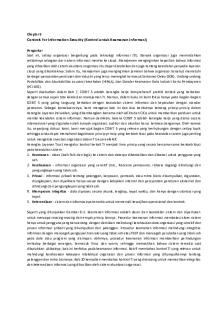CHAPTER 8 CASE STUDY : Information security threats and policies in DOCX

| Title | CHAPTER 8 CASE STUDY : Information security threats and policies in |
|---|---|
| Author | Puganiswari Puganis |
| Pages | 3 |
| File Size | 18.7 KB |
| File Type | DOCX |
| Total Downloads | 70 |
| Total Views | 114 |
Summary
CHAPTER 8 CASE STUDY : Information security threats and policies in Europe 1) What is a botnet? In the term "botnet" as used here, the "bot" is short for robot. A single bot is a software program that can, when surreptitiously installed on a person's computer, execute certain...
Description
CHAPTER 8 CASE STUDY : Information security threats and policies in Europe 1) What is a botnet? In the term "botnet" as used here, the "bot" is short for robot. A single bot is a software program that can, when surreptitiously installed on a person's computer, execute certain specified commands. Botnet is a network of autonomous malicious software agent there are under the control of a bot commander. The network is created by installing malware that exploits the vulnerabilities of Web servers, operating systems, or application to take control of the infected computers. A botnet also refer to the collection of internet –connected programs in order to perform task. This can be as mundane as keeping control of an internet relay chat (IRC) channel, or it could be used to send spam email or participate in distributed denial-of-service attacks. The world botnet is a portmanteau of robot and network. 2) Describe some of the main points of the Digital Agenda of Europe. The main point of the Digital Agenda of Europe is to define the key role that information and communication technologies will play in 2020.The initiative calls of a single, open Europe digital market. Another goal is that broadband speed of 30Mbps be available to all European citizen by 2020 in term of security, the initiative is considering the implementation of measure to protect privacy and the establishment of a well-functioning network of CERT to prevent cybercrime and respond effectively to cyber-attacks. The European Commission has proposed a Digital Agenda. Its main objective is to develop a digital single market in order to generate smart, sustainable and inclusive growth in Europe. The obstacles hindering the Digital Agenda are the:- fragmented digital markets; lack of interoperability; rising cybercrime and risk of low trust in networks; lack of investment in networks; insufficient research and innovation efforts; lack of digital literacy and skills; missed opportunities in addressing societal challenges...
Similar Free PDFs

Homeland Security: Case Study
- 4 Pages

Information Assurance and Security 1
- 10 Pages

Tn-information-security
- 22 Pages

Quiz 1 Information Security
- 2 Pages

Information Security-Week1 Notes
- 5 Pages
Popular Institutions
- Tinajero National High School - Annex
- Politeknik Caltex Riau
- Yokohama City University
- SGT University
- University of Al-Qadisiyah
- Divine Word College of Vigan
- Techniek College Rotterdam
- Universidade de Santiago
- Universiti Teknologi MARA Cawangan Johor Kampus Pasir Gudang
- Poltekkes Kemenkes Yogyakarta
- Baguio City National High School
- Colegio san marcos
- preparatoria uno
- Centro de Bachillerato Tecnológico Industrial y de Servicios No. 107
- Dalian Maritime University
- Quang Trung Secondary School
- Colegio Tecnológico en Informática
- Corporación Regional de Educación Superior
- Grupo CEDVA
- Dar Al Uloom University
- Centro de Estudios Preuniversitarios de la Universidad Nacional de Ingeniería
- 上智大学
- Aakash International School, Nuna Majara
- San Felipe Neri Catholic School
- Kang Chiao International School - New Taipei City
- Misamis Occidental National High School
- Institución Educativa Escuela Normal Juan Ladrilleros
- Kolehiyo ng Pantukan
- Batanes State College
- Instituto Continental
- Sekolah Menengah Kejuruan Kesehatan Kaltara (Tarakan)
- Colegio de La Inmaculada Concepcion - Cebu










